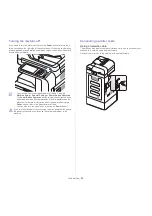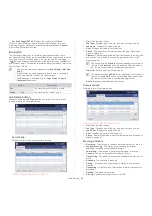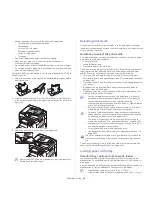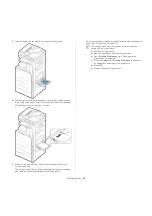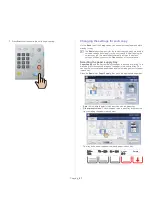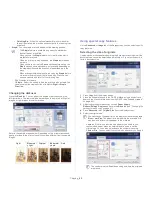
Media and tray
_ 52
Printing on special media
The table below shows the available special media for each tray.
When using special media, we recommend you feed a piece of paper
at a time. Check the maximum input number of media for each tray
(see "Print media specifications" on page 249).
The media types are shown in the
Printing Preferences
. This paper type
option allows you to set the type of paper to be loaded in the tray. This
setting appears in the list so that you can select it. This will let you get the
best quality printout. If not, the desired print quality may not be achieved.
•
Plain:
71 to 90 g/m
2
(19 to 24 lb) normal plain paper.
•
Thick:
91 to 105 g/m
2
(25 to 28 lb) thick paper.
•
Heavy Weight:
106 to 175 g/m
2
(29 to 46 lb) thick paper.
•
Extra Heavy Weight 1:
176 to 216 g/m
2
(47 to 57 lb) thick paper.
•
Extra Heavy Weight 2:
217 to 253 g/m
2
(58 to 67 lb) thick paper.
•
Thin:
60 to 70 g/m
2
(16 to 18 lb) thin paper.
•
Bond:
105 to 120 g/m
2
(28 to 32 lb) bond.
•
Color:
75 to 90 g/m
2
(20 to 24 lb) color-backgrounded paper.
•
Labels:
120 to 150 g/m
2
(32 to 40 lb) label.
•
Transparency:
138 to 146 g/m
2
(37 to 39 lb) transparency paper.
•
Envelope:
75 to 90 g/m
2
(20 to 24 lb) envelope.
•
Preprinted:
75 to 90 g/m
2
(20 to 24 lb) preprinted paper.
•
Cotton:
75 to 90 g/m
2
(20 to 24 lb) cotton paper.
•
Recycled:
60 to 90 g/m
2
(16 to 24 lb) recycled paper.
•
Archive:
70 to 90 g/m
2
(19 to 24 lb) If you need to keep the print-out for
a long time, such as archives, select this option.
•
Letterhead:
70 to 90 g/m
2
(19 to 24 lb).
•
Punched:
70 to 90 g/m
2
(19 to 24 lb) .
•
Thin CardStock:
105 to 163 g/m
2
(28 to 43 lb) cardstock.
•
Thick CardStock:
170 to 216 g/m
2
(45 to 57 lb) cardstock.
•
Thin Glossy:
106 to 169 g/m
2
(28 to 45 lb) glossy paper.
•
Thick Glossy:
170 to 253 g/m
2
(45 to 67 lb) glossy paper.
Envelope
Successful printing on envelopes depends upon the quality of the
envelopes.
To print an envelope, place it with the flap side up.
•
When selecting envelopes, consider the following factors:
-
Weight:
The weight of the envelope paper should not exceed
90 g/m
2
(16 lb) otherwise, a jam may occur.
-
Construction:
Prior to printing, envelopes should lie flat with less
than 6 mm (0.25 inches) curl, and should not contain air.
-
Condition:
Envelopes should not be wrinkled, nicked, or damaged.
-
Temperature:
Use envelopes that are compatible with the heat and
pressure of the machine during operation.
•
Use only well-constructed envelopes with sharp-and well-creased folds.
•
Do not use stamped envelopes.
•
Do not use envelopes with clasps, snaps, windows, coated lining,
self-adhesive seals, or other synthetic materials.
•
Do not use damaged or poorly made envelopes.
•
Be sure the seam at both ends of the envelope extends all the way to
the corner of the envelope.
1
Acceptable
2
Unacceptable
•
Envelopes with a peel-off adhesive strip or with more than one flap that
folds over to seal must use adhesives compatible with the machine’s
Types
Standard tray/
optional dual
cassette feeder
Multi-purpose tray
Thick
O
O
Heavy
weight
O
O
Extra
Heavy
weight 1
O
O
Extra
Heavy
weight 2
X
O
Thin
O
O
Cotton
O
O
Color
O
O
Preprinted
O
O
Recycled
O
O
Bond
O
O
Archive
O
O
Letterhead
O
O
Punched
O
O
Thin Cardstock
O
O
Thick Cardstock
O
O
Thin Glossy
X
O
Thick Glossy
X
O
Envelope
X
O
Transparency
X
O
Labels
O
O


